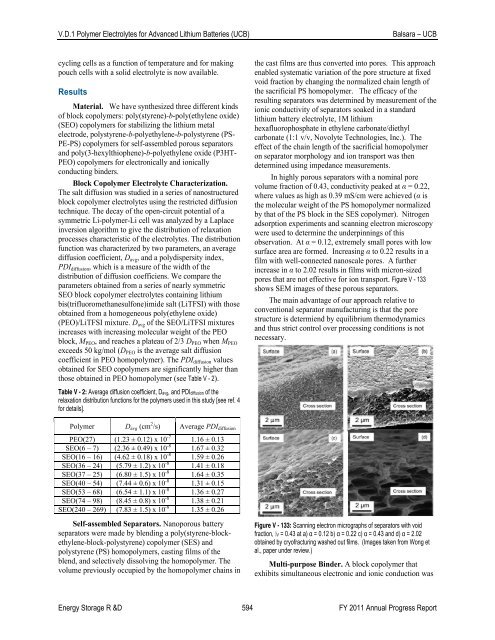V. Focused Fundamental Research - EERE - U.S. Department of ...
V. Focused Fundamental Research - EERE - U.S. Department of ...
V. Focused Fundamental Research - EERE - U.S. Department of ...
You also want an ePaper? Increase the reach of your titles
YUMPU automatically turns print PDFs into web optimized ePapers that Google loves.
V.D.1 Polymer Electrolytes for Advanced Lithium Batteries (UCB)<br />
Balsara – UCB<br />
cycling cells as a function <strong>of</strong> temperature and for making<br />
pouch cells with a solid electrolyte is now available.<br />
Results<br />
Material. We have synthesized three different kinds<br />
<strong>of</strong> block copolymers: poly(styrene)-b-poly(ethylene oxide)<br />
(SEO) copolymers for stabilizing the lithium metal<br />
electrode, polystyrene-b-polyethylene-b-polystyrene (PS<br />
PE-PS) copolymers for self-assembled porous separators<br />
and poly(3-hexylthiophene)-b-polyethylene oxide (P3HT<br />
PEO) copolymers for electronically and ionically<br />
conducting binders.<br />
Block Copolymer Electrolyte Characterization.<br />
The salt diffusion was studied in a series <strong>of</strong> nanostructured<br />
block copolymer electrolytes using the restricted diffusion<br />
technique. The decay <strong>of</strong> the open-circuit potential <strong>of</strong> a<br />
symmetric Li-polymer-Li cell was analyzed by a Laplace<br />
inversion algorithm to give the distribution <strong>of</strong> relaxation<br />
processes characteristic <strong>of</strong> the electrolytes. The distribution<br />
function was characterized by two parameters, an average<br />
diffusion coefficient, D avg , and a polydispersity index,<br />
PDI diffusion , which is a measure <strong>of</strong> the width <strong>of</strong> the<br />
distribution <strong>of</strong> diffusion coefficiens. We compare the<br />
parameters obtained from a series <strong>of</strong> nearly symmetric<br />
SEO block copolymer electrolytes containing lithium<br />
bis(trifluoromethanesulfone)imide salt (LiTFSI) with those<br />
obtained from a homogeneous poly(ethylene oxide)<br />
(PEO)/LiTFSI mixture. D avg <strong>of</strong> the SEO/LiTFSI mixtures<br />
increases with increasing molecular weight <strong>of</strong> the PEO<br />
block, M PEO , and reaches a plateau <strong>of</strong> 2/3 D PEO when M PEO<br />
exceeds 50 kg/mol (D PEO is the average salt diffusion<br />
coefficient in PEO homopolymer). The PDI diffusion values<br />
obtained for SEO copolymers are significantly higher than<br />
those obtained in PEO homopolymer (see Table V - 2).<br />
the cast films are thus converted into pores. This approach<br />
enabled systematic variation <strong>of</strong> the pore structure at fixed<br />
void fraction by changing the normalized chain length <strong>of</strong><br />
the sacrificial PS homopolymer. The efficacy <strong>of</strong> the<br />
resulting separators was determined by measurement <strong>of</strong> the<br />
ionic conductivity <strong>of</strong> separators soaked in a standard<br />
lithium battery electrolyte, 1M lithium<br />
hexafluorophosphate in ethylene carbonate/diethyl<br />
carbonate (1:1 v/v, Novolyte Technologies, Inc.). The<br />
effect <strong>of</strong> the chain length <strong>of</strong> the sacrificial homopolymer<br />
on separator morphology and ion transport was then<br />
determined using impedance measurements.<br />
In highly porous separators with a nominal pore<br />
volume fraction <strong>of</strong> 0.43, conductivity peaked at α = 0.22,<br />
where values as high as 0.39 mS/cm were achieved (α is<br />
the molecular weight <strong>of</strong> the PS homopolymer normalized<br />
by that <strong>of</strong> the PS block in the SES copolymer). Nitrogen<br />
adsorption experiments and scanning electron microscopy<br />
were used to determine the underpinnings <strong>of</strong> this<br />
observation. At α = 0.12, extremely small pores with low<br />
surface area are formed. Increasing α to 0.22 results in a<br />
film with well-connected nanoscale pores. A further<br />
increase in α to 2.02 results in films with micron-sized<br />
pores that are not effective for ion transport. Figure V - 133<br />
shows SEM images <strong>of</strong> these porous separators.<br />
The main advantage <strong>of</strong> our approach relative to<br />
conventional separator manufacturing is that the pore<br />
structure is determiend by equilibrium thermodynamics<br />
and thus strict control over processing conditions is not<br />
necessary.<br />
Table V - 2: Average diffusion coefficient, Davg, and PDIdiffusion <strong>of</strong> the<br />
relaxation distribution functions for the polymers used in this study [see ref. 4<br />
for details].<br />
Polymer D avg (cm 2 /s) Average PDI diffusion<br />
PEO(27) (1.23 ± 0.12) x 10 -7 1.16 ± 0.13<br />
SEO(6 – 7) (2.36 ± 0.49) x 10 -8 1.67 ± 0.32<br />
SEO(16 – 16) (4.62 ± 0.18) x 10 -8 1.59 ± 0.26<br />
SEO(36 – 24) (5.79 ± 1.2) x 10 -8 1.41 ± 0.18<br />
SEO(37 – 25) (6.80 ± 1.5) x 10 -8 1.64 ± 0.35<br />
SEO(40 – 54) (7.44 ± 0.6) x 10 -8 1.31 ± 0.15<br />
SEO(53 – 68) (6.54 ± 1.1) x 10 -8 1.36 ± 0.27<br />
SEO(74 – 98) (8.45 ± 0.8) x 10 -8 1.38 ± 0.21<br />
SEO(240 – 269) (7.83 ± 1.5) x 10 -8 1.35 ± 0.26<br />
Self-assembled Separators. Nanoporous battery<br />
separators were made by blending a poly(styrene-blockethylene-block-polystyrene)<br />
copolymer (SES) and<br />
polystyrene (PS) homopolymers, casting films <strong>of</strong> the<br />
blend, and selectively dissolving the homopolymer. The<br />
volume previously occupied by the homopolymer chains in<br />
Figure V - 133: Scanning electron micrographs <strong>of</strong> separators with void<br />
fraction, V = 0.43 at a) α = 0.12 b) α = 0.22 c) α = 0.43 and d) α = 2.02<br />
obtained by cry<strong>of</strong>racturing washed out films. (Images taken from Wong et<br />
al., paper under review.)<br />
Multi-purpose Binder. A block copolymer that<br />
exhibits simultaneous electronic and ionic conduction was<br />
Energy Storage R &D 594 FY 2011 Annual Progress Report



